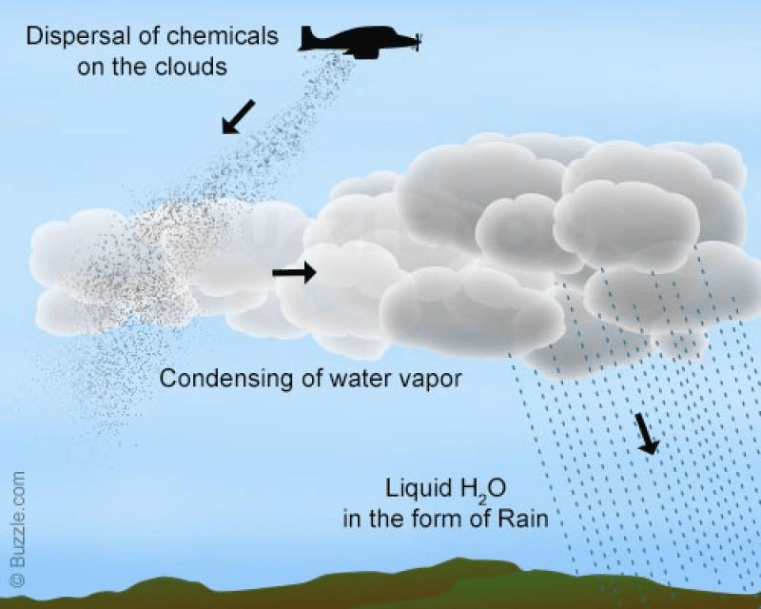ARTIFICIAL RAINING: CLOUD SEEDING
Recently, Indian Institute of Technology (IIT) Kanpur has successfully conducted a test flight for cloud seeding.
About Cloud Seeding
Cloud seeding is a kind of a weather modification technology to create artificial rainfall.
o Rain happens when moisture in the air reaches levels at which it can no longer be held.
o Cloud seeding aims to facilitate and accelerate that process by making available chemical ‘nuclei’ around which condensation can take place.
- It works only when there is enough pre-existing clouds in the atmosphere.
- Two ways of adding nuclei particles to clouds:
o Using large cannons that shoot particles into the sky
o Using airplanes that drop the particles from above.
✓ IIT Kanpur used this method.
✓ Cloud Aerosol Interaction and Precipitation Enhancement Experiment (CAIPEX) – IV was conducted during two consecutive monsoon seasons of 2018 and 2019 over Solapur, Maharashtra.
Mainly 8 Chemicals are used in Cloud seeding: Silver iodide, dry ice, Potassium Iodide, Propane, Calcium Carbide, Ammonium Nitrate, Sodium Chloride, Urea Compound.
Benefits of Cloud seeding
- Drought management: Cloud seeding technique is useful for drought affected areas. As per India Meteorological Department (IMD), 87% of India’s districts vulnerable to droughts.
- Clearing fog in airports: During fog season many flight gets affected due to lowering visibility hence cloud seeding technique can help to improve the visibility.
- Fight forest fires: As per India State of Forest Report (2021), 35.46% of the forest cover is prone to forest fires. Rain through cloud seeding will help to reduce the forest fire affected region.
- Suppress hail: As seeding accelerates hail embryos growth at lower level in the cloud, where liquid water content is smaller and updrafts are weaker.
- Divert rainfall: Clouds can be diverted to other region based on requirement such as during 2008 Olympics opening ceremony Beijing used it to make ceremony precipitation-free.
- Improve water availability: Cloud seeding will help to distribute rainfall across the country and hence help to recharge aquifers.
Issues in Cloud seeding
- Bioaccumulation: For example Silver iodide chemical is most commonly used to seed a cloud is known to be toxic for aquatic life because of bioaccumulation.
o Bioaccumulation is a process of accumulation of chemicals in an organism that takes place if the rate of intake exceeds the rate of excretion.
- Increasing Carbon footprint: Cloud seeding through dry ice (Carbon di oxide) is source of Greenhouse Gases and affects the climate change.
- Uncertainty on effectiveness: The World Meteorological Organization adopted guidelines in 2017 advising members not to perform weather modification activities without considering the high levels of uncertainty in effectiveness and potential harms involved.
- Not all types of clouds are suitable: Clouds must be deep enough and of a suitable temperature (between -10 and – 12 degrees Celsius) to be seeded effectively.
- Disturbing the Hydrological cycles: Cloud seeding simply redistributes rain in drought affected areas which can ultimately affect the Hydrological cycles.
Conclusion
Cloud seeding technology holds significant promise for addressing water scarcity and mitigating drought conditions.
However, to fully unlock its potential, further improvements are needed. Such as incorporating nanotechnology-based Titanium dioxide coating on salt particles can enhance the effectiveness of cloud seeding operations. Nevertheless, it is imperative to conduct extensive research to fully comprehend the long-term implications and potential risks associated with cloud seeding.
https://todaynewslife.com/a-rare-aurora-phenomenon-for-the-very-first-time-in-ladakh/

